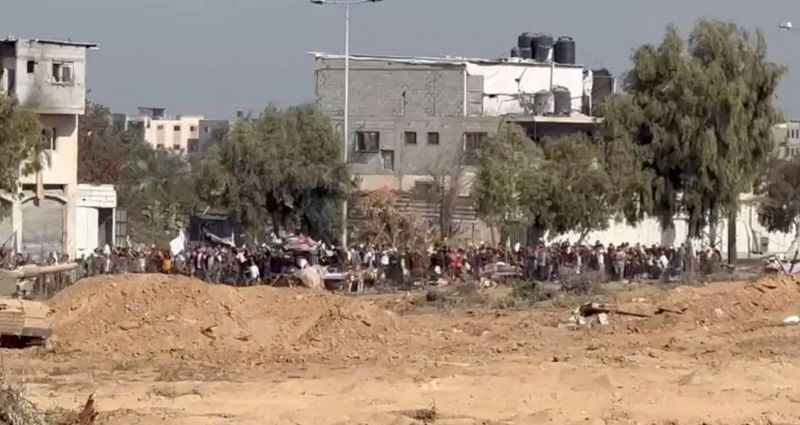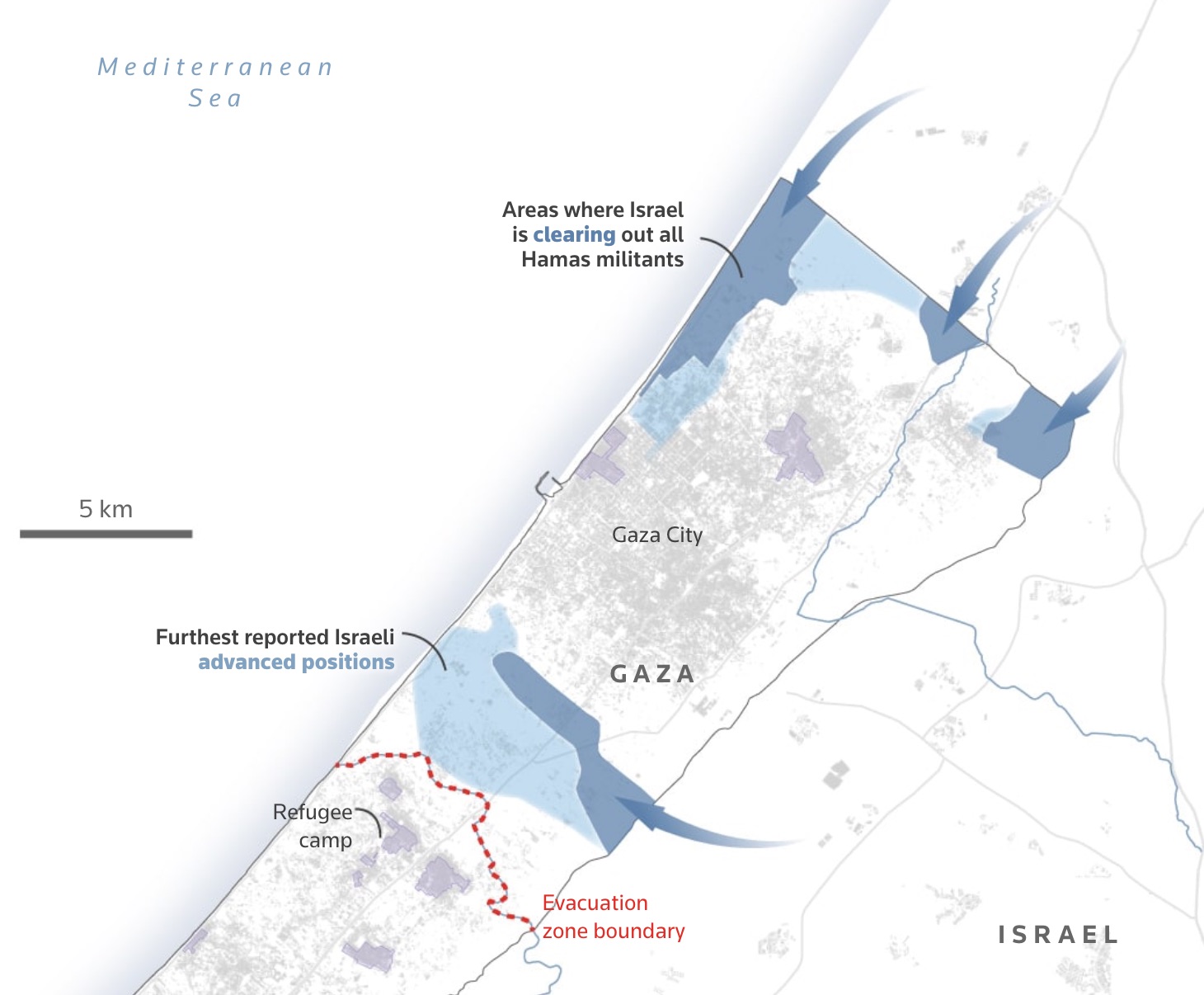
A screenshot taken from a video shows Palestinians holding white flags as they march from northern Gaza to the south, Nov. 7 2023. (Credit: Israeli Army/Handout via Reuters)
“The troops operating in Gaza have cut it in two,” said Israeli Army spokesman Daniel Hagari on Nov. 6 in an interview with CNN. On Monday, the Israeli Army announced that it encircled Gaza City and divided the besieged enclave in half — into North Gaza and South Gaza — as it prepares for a ground attack.
On day 31 of the Israel-Hamas war that erupted after Hamas’ deadly Oct. 7 assault on Israel, Israeli Army spokesman Lieutenant-Colonel Richard Hecht declared, “We’ve completed our encirclement, separating Hamas strongholds in the north and the south.” The stated aim of the division was to destroy the Hamas command structure.
According to Israel’s Defense Minister Yoav Gallant, the troops were “in the heart of [Gaza] city,” the enclave’s largest city, on Tuesday evening, despite fears that the face-to-face combat would cause countless civilian casualties.
 Sources: Institute for the Study of War and AEI Critical Threats project; United Nations Office for the Coordination of Humanitarian Affairs (OCHA); Global Human Settlement (European Commision); OpenStreetMap/via Reuters
Sources: Institute for the Study of War and AEI Critical Threats project; United Nations Office for the Coordination of Humanitarian Affairs (OCHA); Global Human Settlement (European Commision); OpenStreetMap/via Reuters
What does it mean that Gaza is split in half?
According to Stephen Biddle, professor of international and public affairs at Columbia University, when an army cuts an opposing force in two, this is usually to cut half of it off from resupply, and to prevent forces from being transferred from one half to the other. “This enables each to be defeated piecemeal,” said Biddle, who is also an adjunct senior fellow for defense policy at the Council on Foreign Relations (CFR). “I assume this is at least part of the IDF’s rationale for doing this in Gaza,” he continued.
Biddle posited two hypotheses regarding the subsequent objectives of the Israeli army in dividing Gaza. “Some have speculated that the IDF will use the areas it has taken as bases for commando raids into southern Gaza. If so, then perhaps they might not choose to occupy the rest of the strip,” said Biddle. On the other hand, he recalled the Israeli army’s usual hypothesis of “eventually having to reoccupy the entire strip, even if only temporarily, if it wants to find and destroy Hamas’ entire military structure.”
It’s a “long way ahead” to destroying Hamas
At the moment, the objectives achieved by the Israeli army are “intermediate military goals,” Biddle said. “The Tsahal army have killed some Hamas leaders, they have destroyed some Hamas tunnels and weapons caches, and they have apparently cut northern Gaza off from the south. But these are only intermediate goals,” he noted. “The declared Israeli war aim is to destroy Hamas, they have a long way to go before they accomplish this.”
Since the Israeli army announced splitting Gaza into two, its troops are “slowly closing in” on Gaza City, said Hecht on Monday. “The IDF air force and navy struck over 450 targets in the previous 24 hours, including Hamas military compounds, observation posts and firing positions,” wrote the Washington-based Institute for the Study of War (ISW) on its website. “The IDF said that it seized a Hamas position used for various military operations,” added the ISW.
Israeli bombardments of Palestinian territory have already injured at least 26,000 people and killed over 10,328, mostly civilians, including 4,237 children and 2,741 women, according to the latest figures released midday on Tuesday by Gaza’s Health Ministry. According to Israeli authorities, more than 1,400 people died in Israel, most of which were civilians killed on the day of the Hamas attack, the deadliest in the country’s history. Hamas also took more than 240 hostages.
“It has been one full month of carnage, of incessant suffering, bloodshed, destruction, outrage and despair,” stated UN High Commissioner for Human Rights Volker Turk on Tuesday, as he began a five-day visit through the Middle East, starting in Cairo. “Human rights violations are at the root of this escalation, and human rights play a central role in finding a way out of this vortex of pain,” he added.
Humanitarian corridor
In the north of the Gaza Strip, fighting between Israel and Hamas has raged since Oct. 27, when the Israeli army began its ground operation in the coastal enclave. “Israeli ground forces advanced along the northwestern Gazan coast amid reports of clashes with Hamas in the area,” reported the ISW.
According to Middle East Eye, Israeli troops also made a breakthrough on the eastern front. “Israel has advanced about 6 km along the northwest coastline around Beit Lahia and has reached the southeast of Netzarim and al-Zeitoun from its advance around Johr al-Dik,” they reported.
“The strikes are being carried out against Hamas’s underground infrastructure, in various populated areas, by ground troops, infantry, artillery and combat engineers who are leading the battle along with the air force and intelligence on the ground,” said IDF spokesman Jonathan Conricus in a video posted on X (formerly Twitter).
“We are focusing on Hamas militants and more particularly its leadership,” Conricus added. “Our troops inside Gaza, and particularly the ground units, are proceeding neighborhood by neighborhood, house by house. We are clearing out basements, supported by artillery and air force fire,” he said.
The al-Qassam brigades, Hamas’ military wing, posted images of their militants operating in the vicinity of the Shati refugee camp, in the northwest of the Gaza Strip.
According to ISW, “both the al-Quds Brigades, the military wing of Palestinian Islamic Jihad, and the al-Aqsa Martyrs Brigade said they targeted Israeli vehicles in northwestern Gaza Nov. 5.”
It was within this context that Conricus called on civilians to leave northern Gaza on Monday. “We will be less limited in what we can do,” he said. “We will be able to dismantle Hamas, stronghold after stronghold, battalion after battalion, until we achieve the ultimate goal, which is to rid the Gaza Strip, the entire Gaza Strip, of Hamas,” Conricus continued.
The Israeli army said it opened a humanitarian corridor to allow civilians from northern Gaza and Gaza City to reach the south, beyond Wadi Gaza. “We are still allowing passage for civilians from northern Gaza and Gaza City to the south,” said Hagari, while hundreds of thousands of people remain stuck in the north.
The passage, which was accessible between 10 a.m. and 2 p.m. on Monday, runs through the main Salah al-Din road, which stretches 45 kilometers and runs north to south across the strip. Today, inhabitants of northern Gaza continue to escape to the south.
This article was originally published in French in L'Orient-Le Jour. Translation by Joelle El Khoury.
